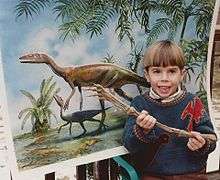Nedcolbertia
Nedcolbertia is a genus of theropod dinosaur from the Early Cretaceous Period of North America.
| Nedcolbertia | |
|---|---|
 | |
| Six year-old Justin Hofmann holding the hindlimb of his namesake dinosaur, Nedcolbertia justinhofmanni. | |
| Scientific classification | |
| Kingdom: | Animalia |
| Phylum: | Chordata |
| Clade: | Dinosauria |
| Clade: | Saurischia |
| Clade: | Theropoda |
| Clade: | †Ornithomimosauria |
| Genus: | †Nedcolbertia Kirkland et al., 1998 |
| Type species | |
| †Nedcolbertia justinhofmanni Kirkland et al., 1998 | |
Discovery and naming
Three skeletons of a theropod were discovered in 1993 by Christopher Whittle near Cisco in the basal Yellow Cat Member of the Cedar Mountain Formation of Utah, dating to the Barremian. These were subsequently studied and reported in 1995 by Kirkland, Britt, Madsen and Burge.[1] Though in 1996 it had been announced that the taxon would be named "Nedcolbertia whittlei", in 1998 it was actually described and named by Kirkland, Whittle, Britt, Madsen and Burge as the type species Nedcolbertia justinhofmanni. The generic name honours the American palaeontologist Edwin Harris Colbert, known as "Ned" to his friends. The specific name honoured Justin Hofmann, a six-year-old school boy from Newton, New Jersey, a participant of a contest for children by Discover Card, the winner having a dinosaur named after him.[2]
Description

The holotype, CEUM 5071, is one of the specimens, a partial skeleton lacking the skull. It belonged to a juvenile individual. The paratypes are the other two specimens: CEUM 5072 and CEUM 5073, both fragmentary skeletons again lacking the skull. They represent subadult individuals. All three specimens were disarticulated and heavily eroded, having been exposed at the surface before discovery. They are part of the collection of the College of Eastern Utah Prehistoric Museum.[2]
The holotype of Nedcolbertia had a length of about 1.5 metres (4 ft 11 in). The paratypes, though not yet full-grown, were about 3 metres (9.8 ft). Due to the condition of the remains, information on the species is limited. The vertebrae were not heavily pneumatised. The thumb claw was much larger than the second claw of the hand. The pubic bone carried a large "foot" with a very small or absent anterior process but a large posterior process. The thigh bone had a lesser trochanter that was clearly lower than the greater trochanter; the fourth trochanter was well-developed. The foot was not arctometatarsal. An enlarged second foot claw was lacking.[2]
The describers assigned Nedcolbertia with certainty to the Tetanurae and provisionally to the Coelurosauria.[2] A 2016 overview of ornithomimosaur material from the Arundel Formation of Maryland found Nedcolbertia to be an ornithomimosaur based on comparisons with the Arundel ornithomimosaur remains, Harpymimus, and Nqwebasaurus.[3]
References
- J. I. Kirkland, C. H. Whittle, B. B. Britt, S. Madsen and D. Burge. A Small Theropod from the Basal Cedar Mountain Formation (Lower Cretaceous, Barremian) of Eastern Utah. Journal of Vertebrate Paleontology. 15(3), 39A (1995).
- Kirkland, J.I.; Britt, B.B.; Whittle, C.H.; Madsen, S.K.; Burge, D.L. (1998). "A small coelurosaurian theropod from the Yellow Cat Member of the Cedar Mountain Formation (Lower Cretaceous, Barremian) of eastern Utah". New Mexico Museum of Natural History and Science Bulletin. 14: 239–248.
- Brownstein, C.D. (2017). "Redescription of Arundel Clay ornithomimosaur material and a reinterpretation of Nedcolbertia justinhofmanni as an "Ostrich Dinosaur": biogeographic implications". PeerJ. 5: e3110. doi:10.7717/peerj.3110. PMC 5345386. PMID 28286718.
Further reading
- Kirkland, J. I. Biogeography of Western North America's Mid-Cretaceous Dinosaur Faunas: Losing European Ties and the First Great Asian-North American Interchange. Journal of Vertebrate Paleontology. 16(3), 45A (1996).
External links


















